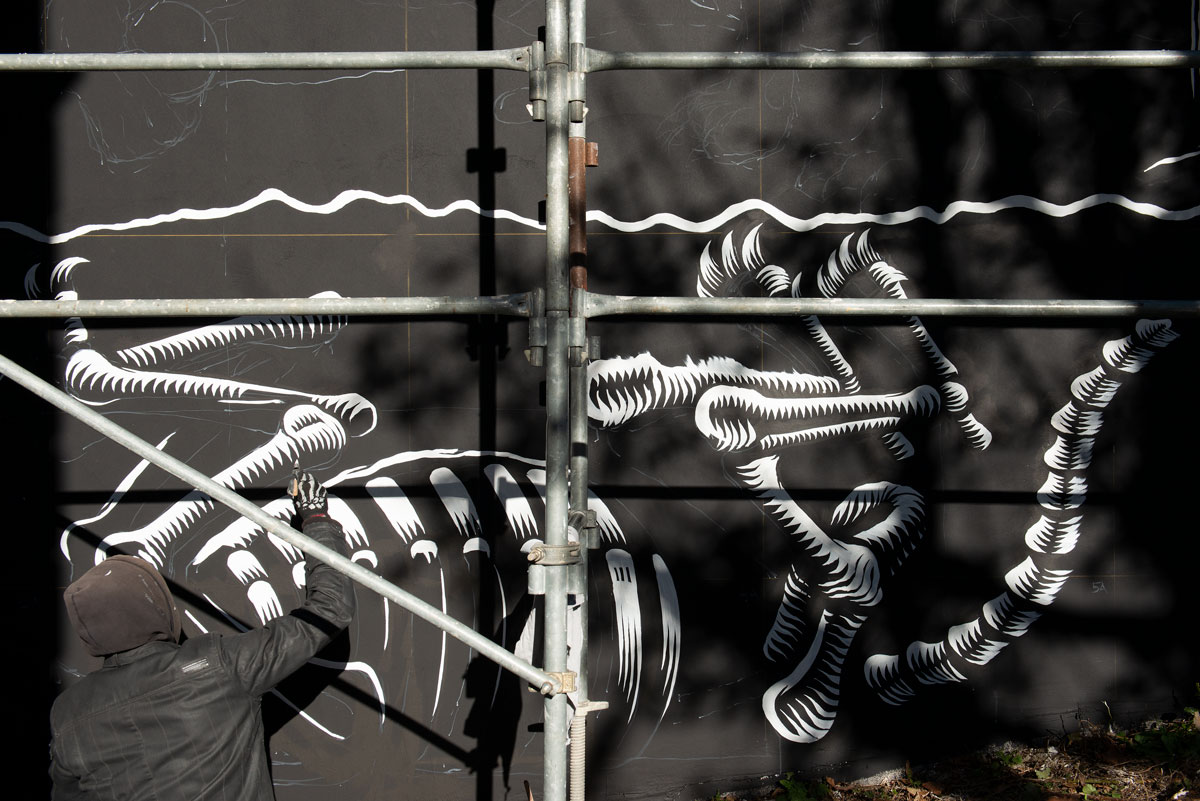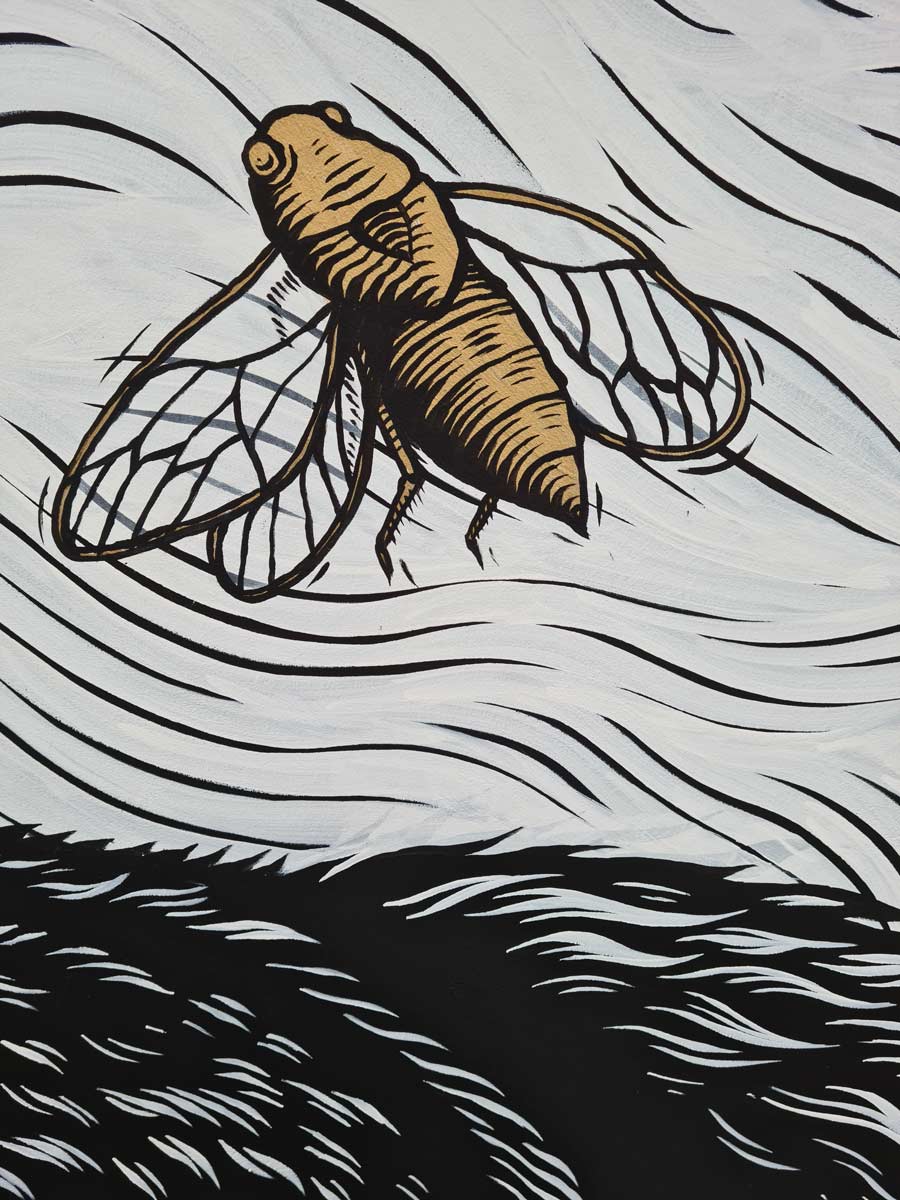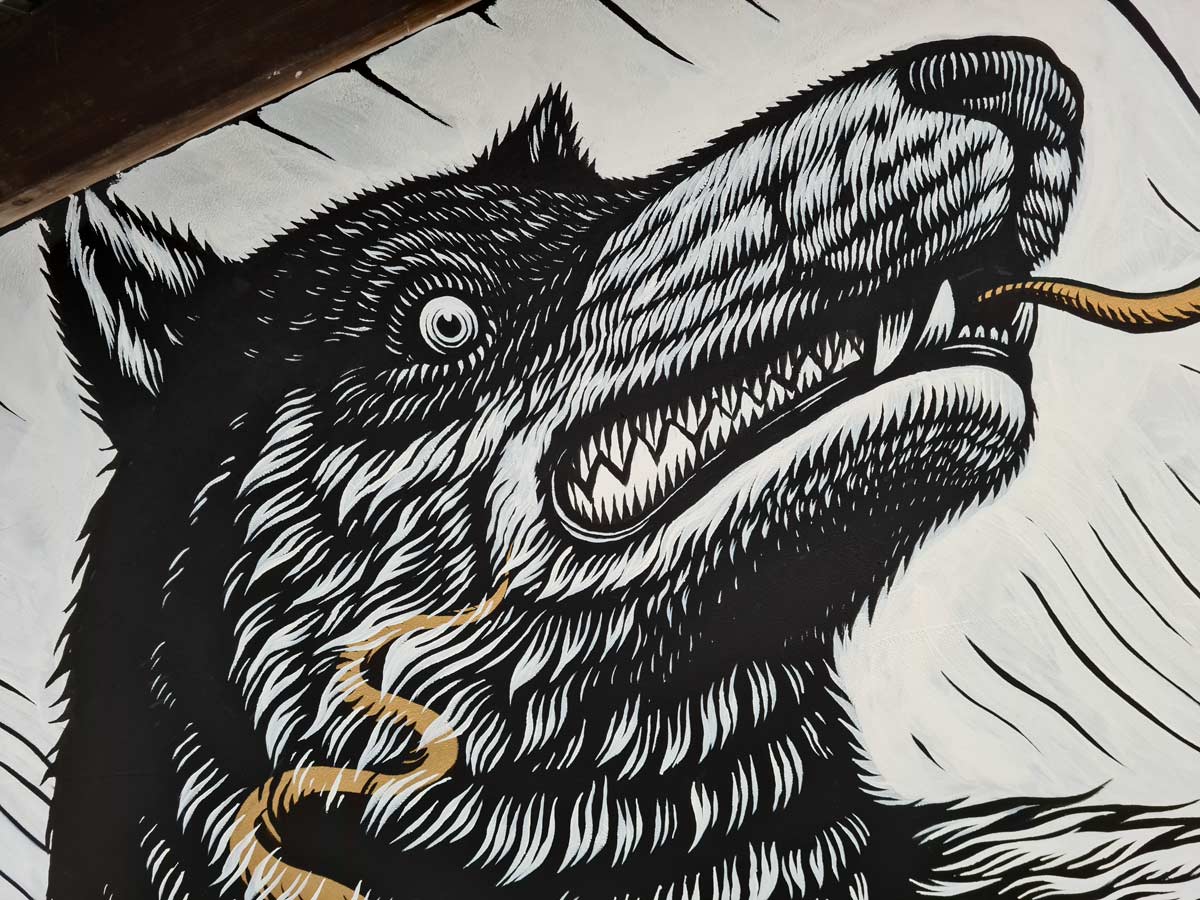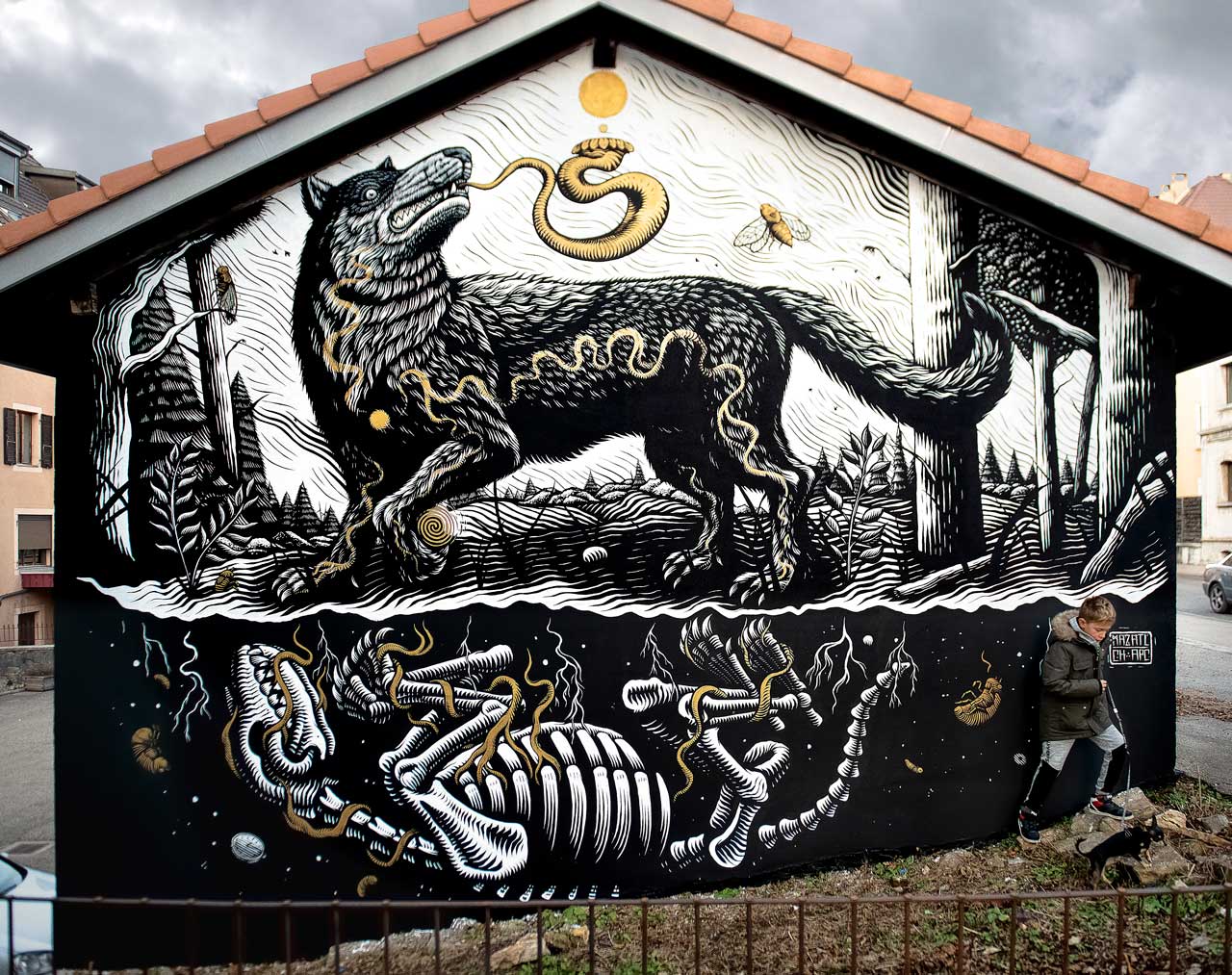Mazatl
[MX]
- THE WORK -
Ancestral Breath
Title: Ancestral Breath
Technique: paintbrush
YEAR CREATED: 2022
Location: Rue des Envers [Garage in front of number 9]
SURFACE AREA: 37 m2
Smuggling
« With all his senses alert, the mastiff paused his run at the edge of the wood. His lips curled, he perked up his ears. The air and foliage are buzzing with life. The black trunks of the fir trees creak in the breeze. The wind no longer carries the scent of humans. Instinctively, the dog knows that far from humans, every animal, every plant, every grain of sand is in its place. Emanating from the ground, a powerful, invisible, impalpable energy warms first his limbs, then his whole being. It’s the life force of his ancestors, whose remains nourish the red earth of the forest. These benevolent ancestral spirits question the domestic animal about its loyalty to its master, sometimes capable of the best and often of the worst. Every time a smuggler’s dog allows himself to run away, the prospect of regaining his freedom seems more enviable than that of a pack animal, forced to risk his life in exchange for a meager meal.
As the dawning stars are reflected in his eyes, the mastiff begins to dream of a life without sticks, without chains, without collars that hurt his withers, without harnesses that torture his spine and flanks. The wolf in him urges him to give in to the call of the forest, but his desire to regain his freedom clashes with the habits ingrained in his flesh, the legacy of thousands of years of domestication. »
Heritage
More than an evocation of historical fact, this fresco is a parable about the cycle of life, genetic and cultural inheritance, and what is innate and what is acquired. By reminding us that the past determines both the present and the future, the artist pays tribute to all creatures who have made sacrifices to offer their descendants the chance to perpetuate life. « Every living thing is a link in the continuum of life. It’s important to know where we come from to know who we are and where we’re going », reminds the artist, who believes that people who are bathed in comfort from birth forget the battles that previous generations had to wage to build a more egalitarian society. Aware of the richness of his spiritual and cultural heritage, the artist is concerned that more and more people are cut off from their roots, and that individualism has fragmented families, because family ties are a cardinal value in his eyes.
Xolotl and smuggler's dogs
According to Mesoamerican religious beliefs, Xolotl is a god with canine features who leads the souls of the deceased to the underworld, the subterranean territory of the dead. Thus, by combining two themes – firstly, the smuggler’s dogs and secondly, the links between the living and the dead – the artist builds a bridge between the history of the Neuchâtel Mountains and the mythology of his native country.
Death
During his many travels, Mazatl was able to gauge the resilience of peoples in the face of death. In Europe, skeletons and bones are often seen as ominous symbols, while in Mexico, they are part of folklore. While the overwhelming majority of visitors to the exomusée appreciate his mural, the artist is amused that some may find it morbid. « In the West, life is so comfortable that we forget about death. It becomes a taboo subject, horrible, or at least disturbing. In Mexican culture, death is part of the cycle of life. We don’t associate it with loss, but rather with the spiritual heritage it implies, » emphasizes Mazatl. Isn’t fertile soil made up of dead plants ? « For people living in Paris, New York or London, death is a word you never utter because it burns your lips. The Mexican, on the other hand, frequents it, mocks it, braves it, sleeps with it, celebrates it, it’s one of his favorite amusements and his most faithful love », wrote Octavio Paz in « Le labyrinthe de la solitude » (The Labyrinth of Solitude).
El Día de los Muertos (Day of the Dead)
In Mexico, it is a popular belief that ancestors and the deceased temporarily return to earth during « el Día de los Muertos » (Day of the Dead), to visit their loved ones. Unlike the Christian festival of All Saints’ Day, which evokes a gloomy, sad day, or Halloween, where the afterlife is seen as a terrifying dimension, the festivities of « el Día de los Muertos » are synonymous with popular jubilation, an explosion of color and joie de vivre. To celebrate the departed, their favorite dishes are concocted. Cemeteries are transformed into picnic areas, where young and old alike dance and sing around the graves and altars erected in memory of the departed. Many people paint skulls on their faces and dress up as « calavera Catrina », a female skeleton dressed in rich clothes and often wearing a hat, or as « calavera Catrín », the male version.
Celebrated for millennia, « el Día de los Muertos » has its origins in the beliefs of pre-Hispanic cultures. The Aztecs, Toltecs and other Nahua peoples believed that the deceased were « kept alive » through memory and spirit, and remained members of their community. Thus, for those who share these beliefs, there is no reason to mourn the death of a loved one, and it is disrespectful to the dead to mourn.
Today, more than a celebration of the dead, « el Día de los Muertos » is an opportunity to commemorate the lives of native peoples.
Spirituality and esotericism
This mural is rich in esoteric symbols. Golden swirls symbolize the spiritual communion between the hound and its deceased predecessor. An ectoplasm emanates from the mammal’s mouth. At the top of the emanation, petals form a chalice above which floats the animal’s soul. A spiral of mana energy swirls in the canine’s left foreleg.
Mazatl’s composition is decorated with gold-coloured cicadas. These creatures embody notions of transition, change, transformation (both physical and psychic), patience, resistance and renewal. According to Feng Chui philosophy, the cicada is the symbol of immortality, luck and prosperity. These insects live most of their lives underground, first as eggs, then as nymphs. After a period ranging from a few months to 17 years, depending on the species, they make their way into the open air and begin their adult life, which lasts just one season, the time it takes for them to mate and, for the females, to lay eggs which they bury in the earth. Their song reminds us of the need to work together for the common good, like workers singing in unison to give themselves courage.
Believing that animals are spiritual beings in the same way as humans, Through this mural painting, Mazatl invites us to reconsider our relationship with the animal world and our propensity to subjugate and exploit it.
Deep and mystical, his work contrasts with that of Finnish artist Jussi TwoSeven, which can be admired in the Ruelle de l’Oratoire, also featuring a smuggler’s dog, but in a lighter, even humorous way.
© exomusée – July 2023 – Redaction: François Balmer – Translation: Wolfgang Carrier
Rue des Envers
- THE ARTIST -
Mazatl

Mazatl is a contemporary Mexican artist whose relief prints, murals and installations focus on unity, nature, introspection, healing and liberation. He resides in Chiapas, Mexico.
He dedicates a large part of his work towards collaborating with groups, collectives, other artists and movements that seek social, political and environmental justice in our communities. He is a member of the Justseeds Artists Cooperative and APC (Animal Power Crew).
© exomusée – October 2022 – Redaction: François Balmer – Translation: Wolfgang Carrier
To print the content of the page, please click on the printer icon.
- The exo -
on the web
Thank you for following and supporting the exomusée on Facebook, Instagram and YouTube!







